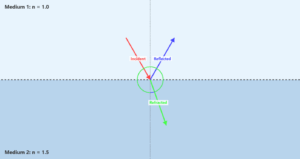Polarized Light Through Crossed Polarizers
Example
Question:
Discuss the intensity of transmitted light when a polaroid sheet is rotated between two crossed polaroids.
Solution:
Let \( I_0 \) be the intensity of polarised light after passing through the first polariser \( P_1 \). After passing through the second polariser \( P_2 \), the intensity is:
\[
I = I_0 \cos^2\theta
\]
where \( \theta \) is the angle between the pass axes of \( P_1 \) and \( P_2 \).
For a third polariser \( P_3 \) crossed with \( P_1 \), and pass axis angle between \( P_2 \) and \( P_3 \) as \( \left( \frac{\pi}{2} - \theta \right) \):
\[
I = I_0 \cos^2\theta \cos^2\left(\frac{\pi}{2} - \theta\right)
\]
\[
= I_0 \cos^2\theta \sin^2\theta
\]
\[
= \frac{I_0}{4}\sin^2 2\theta
\]
Therefore, transmitted intensity is maximum when \( \theta = \frac{\pi}{4} \).
Physics of Crossed Polarizers
1. First Polarizer (P₁): Creates vertically polarized light (I₀).
2. Middle Polarizer (P₂): At angle θ, transmits I₀cos²θ (Malus's Law).
3. Third Polarizer (P₃): Crossed at 90° to P₁, transmits I₀cos²θsin²θ.
Key Points:
- When θ = 0° or 90°, output is 0 (complete blocking)
- Maximum transmission at θ = 45° (25% of original light)
- Without P₂, output would always be 0 (crossed polarizers block all light)

